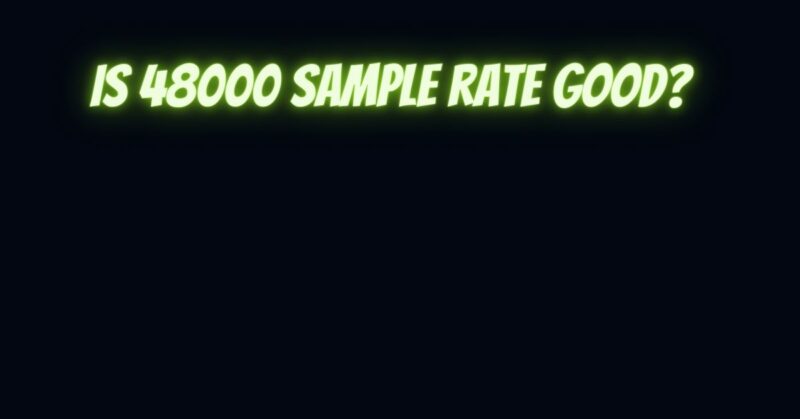When it comes to audio recording and production, selecting the right sample rate is a critical decision that can influence the quality and flexibility of your audio projects. One common sample rate you’ll encounter is 48,000 Hz, often referred to as 48 kHz. In this article, we’ll explore the suitability of a 48 kHz sample rate for audio recording and production and discuss its advantages and considerations.
Understanding 48 kHz Sample Rate
A sample rate of 48 kHz means that 48,000 audio samples are captured per second to represent the audio signal digitally. This sample rate is widely used in audio production and has become a standard for various applications.
Advantages of 48 kHz Sample Rate
- Compatibility: One of the primary advantages of a 48 kHz sample rate is its compatibility with a wide range of audio equipment and platforms. It aligns well with common audio and video standards, making it suitable for multimedia production.
- Video Synchronization: In video production, 48 kHz is often used as the audio sample rate because it perfectly matches the 24 frames per second (fps) frame rate, providing a clean and straightforward synchronization between audio and video.
- Editing and Processing: A 48 kHz sample rate provides ample resolution for audio editing and processing. It allows for detailed audio manipulation during mixing, mastering, and post-production without significant file size limitations.
- Streaming and Broadcasting: Many streaming platforms, broadcasting standards, and content delivery services support audio with a 48 kHz sample rate. Using this sample rate ensures compatibility and consistent audio quality.
- Practicality: 48 kHz strikes a balance between audio quality and practicality. It offers sufficient audio resolution for most applications while keeping file sizes manageable.
Considerations
While 48 kHz is a versatile sample rate, it’s essential to consider specific factors when deciding if it’s suitable for your audio projects:
- Recording Quality: The quality of your recording equipment, including microphones and preamps, can impact the choice of sample rate. High-quality sources may benefit from higher sample rates, but 48 kHz can still yield excellent results.
- Musical Genre: The genre and style of music you’re producing can influence the sample rate choice. Genres with a focus on acoustic subtleties, such as classical or jazz, may benefit from higher sample rates, while others may not require the same level of detail.
- Distribution Format: If your audio will primarily be distributed on platforms that require specific sample rates, check their requirements. Some streaming services may automatically convert uploaded audio to their preferred formats.
- Editing and Processing Needs: Consider the extent of audio editing and processing you plan to perform. While 48 kHz provides ample resolution, some specialized audio tasks may benefit from higher sample rates.
A 48 kHz sample rate is a practical and versatile choice for audio recording and production. It offers compatibility with various platforms, provides sufficient resolution for most applications, and strikes a balance between audio quality and file size. Ultimately, the suitability of a 48 kHz sample rate depends on your specific recording needs, equipment quality, and the intended distribution format. Whether you’re recording music, creating podcasts, or working on video projects, 48 kHz is a reliable and widely accepted sample rate for achieving high-quality audio results.


